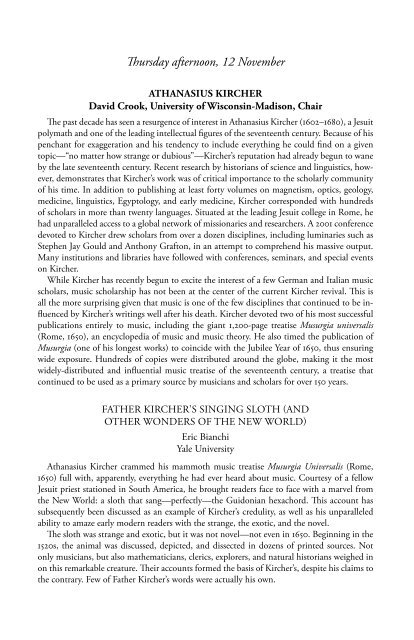AMS Philadelphia 2009 Abstracts - American Musicological Society
AMS Philadelphia 2009 Abstracts - American Musicological Society
AMS Philadelphia 2009 Abstracts - American Musicological Society
Create successful ePaper yourself
Turn your PDF publications into a flip-book with our unique Google optimized e-Paper software.
Thursday afternoon, 12 November<br />
AthAnAsius Kircher<br />
David crook, university of Wisconsin-Madison, chair<br />
The past decade has seen a resurgence of interest in Athanasius Kircher (1602–1680), a Jesuit<br />
polymath and one of the leading intellectual figures of the seventeenth century. Because of his<br />
penchant for exaggeration and his tendency to include everything he could find on a given<br />
topic—“no matter how strange or dubious”—Kircher’s reputation had already begun to wane<br />
by the late seventeenth century. Recent research by historians of science and linguistics, however,<br />
demonstrates that Kircher’s work was of critical importance to the scholarly community<br />
of his time. In addition to publishing at least forty volumes on magnetism, optics, geology,<br />
medicine, linguistics, Egyptology, and early medicine, Kircher corresponded with hundreds<br />
of scholars in more than twenty languages. Situated at the leading Jesuit college in Rome, he<br />
had unparalleled access to a global network of missionaries and researchers. A 2001 conference<br />
devoted to Kircher drew scholars from over a dozen disciplines, including luminaries such as<br />
Stephen Jay Gould and Anthony Grafton, in an attempt to comprehend his massive output.<br />
Many institutions and libraries have followed with conferences, seminars, and special events<br />
on Kircher.<br />
While Kircher has recently begun to excite the interest of a few German and Italian music<br />
scholars, music scholarship has not been at the center of the current Kircher revival. This is<br />
all the more surprising given that music is one of the few disciplines that continued to be influenced<br />
by Kircher’s writings well after his death. Kircher devoted two of his most successful<br />
publications entirely to music, including the giant 1,200-page treatise Musurgia universalis<br />
(Rome, 1650), an encyclopedia of music and music theory. He also timed the publication of<br />
Musurgia (one of his longest works) to coincide with the Jubilee Year of 1650, thus ensuring<br />
wide exposure. Hundreds of copies were distributed around the globe, making it the most<br />
widely-distributed and influential music treatise of the seventeenth century, a treatise that<br />
continued to be used as a primary source by musicians and scholars for over 150 years.<br />
FATHER KIRCHER’S SINGING SLOTH (AND<br />
OTHER WONDERS OF THE NEW WORLD)<br />
Eric Bianchi<br />
Yale University<br />
Athanasius Kircher crammed his mammoth music treatise Musurgia Universalis (Rome,<br />
1650) full with, apparently, everything he had ever heard about music. Courtesy of a fellow<br />
Jesuit priest stationed in South America, he brought readers face to face with a marvel from<br />
the New World: a sloth that sang—perfectly—the Guidonian hexachord. This account has<br />
subsequently been discussed as an example of Kircher’s credulity, as well as his unparalleled<br />
ability to amaze early modern readers with the strange, the exotic, and the novel.<br />
The sloth was strange and exotic, but it was not novel—not even in 1650. Beginning in the<br />
1520s, the animal was discussed, depicted, and dissected in dozens of printed sources. Not<br />
only musicians, but also mathematicians, clerics, explorers, and natural historians weighed in<br />
on this remarkable creature. Their accounts formed the basis of Kircher’s, despite his claims to<br />
the contrary. Few of Father Kircher’s words were actually his own.










